The popularity of keeping parrots as pets has overshadowed the other available pet bird species, species that make endearing pets that are often simpler to care for, and can be highly entertaining when given the opportunity.
The Diamond Dove is one such bird.
 |
| Diamond Dove (Geopelia cuneata) (Photo credit: Wikipedia) |
Diamond Doves are the size of parakeets or budgerigars for those of you in Britain. These birds can live anywhere from five to twenty years old.
The beautiful wild color variation is the most commonly found, with the males bluish-gray on the heads, necks, back, and wings, white tails, white spots on the wings, and a well-defined orange ring around each eye. The female of this color variation has more brown on her head, neck, and wings, and a less well-defined orange eye ring, but is beautiful none the less.
Diamond Doves come in a wide variety of color variations, from the wild type to cinnamon, silver, silver-blue with white tails, soft yellow, to a gorgeous pure white.
The sound the doves make is a gentle 'coo-coo' with the male being somewhat louder during courtship. My female dove Emma's 'coo-coo' is somewhere between a coo and a beep. Diamond Doves are never obnoxiously loud, as so many parrot species are.
Diamond Doves are highly sociable birds always happiest when in the company of their own kind. But these birds are also highly prolific. If you do not want a flock of tiny doves, then purchase only one bird. Be patient and the dove will bond with you in a few weeks' time.
My dove follows me around the house each morning. When she can't find me I hear her coo-coo. I call her name and then mimic her too. I soon hear a flutter of wings as she arrives. I have to be careful not to step on her when she follows me around because Diamond Doves are ground-feeding birds. They spend a lot of time poking about the floor or the bottom of their cage.
The best cage for Diamond Doves should be long rather than high so the birds can fly from perch to perch. A cage two feet by two feet can house a single pair of doves. The birds will even breed in a cage this size.
Remove any wire mesh on the floor of the cage. Your bird or birds will want to pick after fallen seed or grit, or simply sit on the floor from time to time.
 |
| Diamond dove (Photo credit: Wikipedia) |
Feeding a Diamond Dove is simple. A diet of mixed Finch seed with plenty of millet mixed with a vitamin powder will do, with the occasional treat of greens or egg crumbles. Be sure to provide a bowl of grit because doves need the grit to crush seeds. Fresh water should always be available. You can also provide a cuttle bone for calcium, but I find doves get plenty of calcium from their grit. The choice is yours.
Diamond doves have individual personalities best seen when the bird is kept singly in a cage and when bonded with you, much like house cats. He or she may be a fussbudget, a mother hen, aggressive, noisy, laid back, always on the go, or any combination of the above.
Diamond doves can be trained to step onto hand-held perches and even come when called. My dove Emma knows her name and even her nickname ('munchkin bird'). She knows how to nag me into opening her cage and, once out, will often perch on the edge of my laptop while I write, if not on my shoulder. When feeling demonic, she pecks at the keys while I am trying to work. I shoo her off and then she retreats to the houseplants, where she pokes about in the dirt.
Parrots are wonderful birds. But if you are looking for a smaller, quiet, and easier to care for feathered companion, but still a lot of fun, then you owe it to yourself to get better acquainted with the lovely Australian charmer the Diamond Dove.
Jennifer Harker is a freelance writer experienced with writing nonfiction, creative nonfiction, and fiction.
Article Source: EzineArticles
|

No comments:
Post a Comment